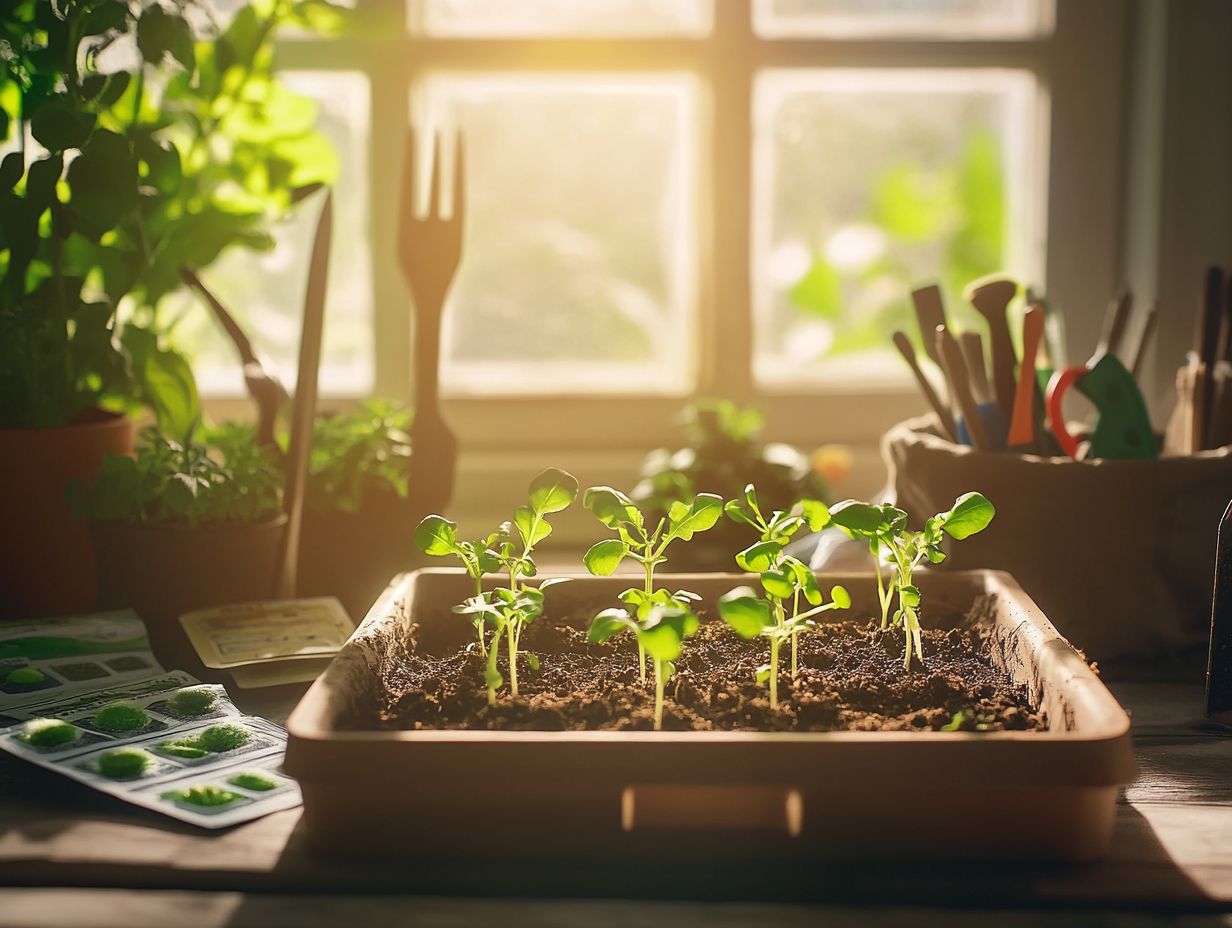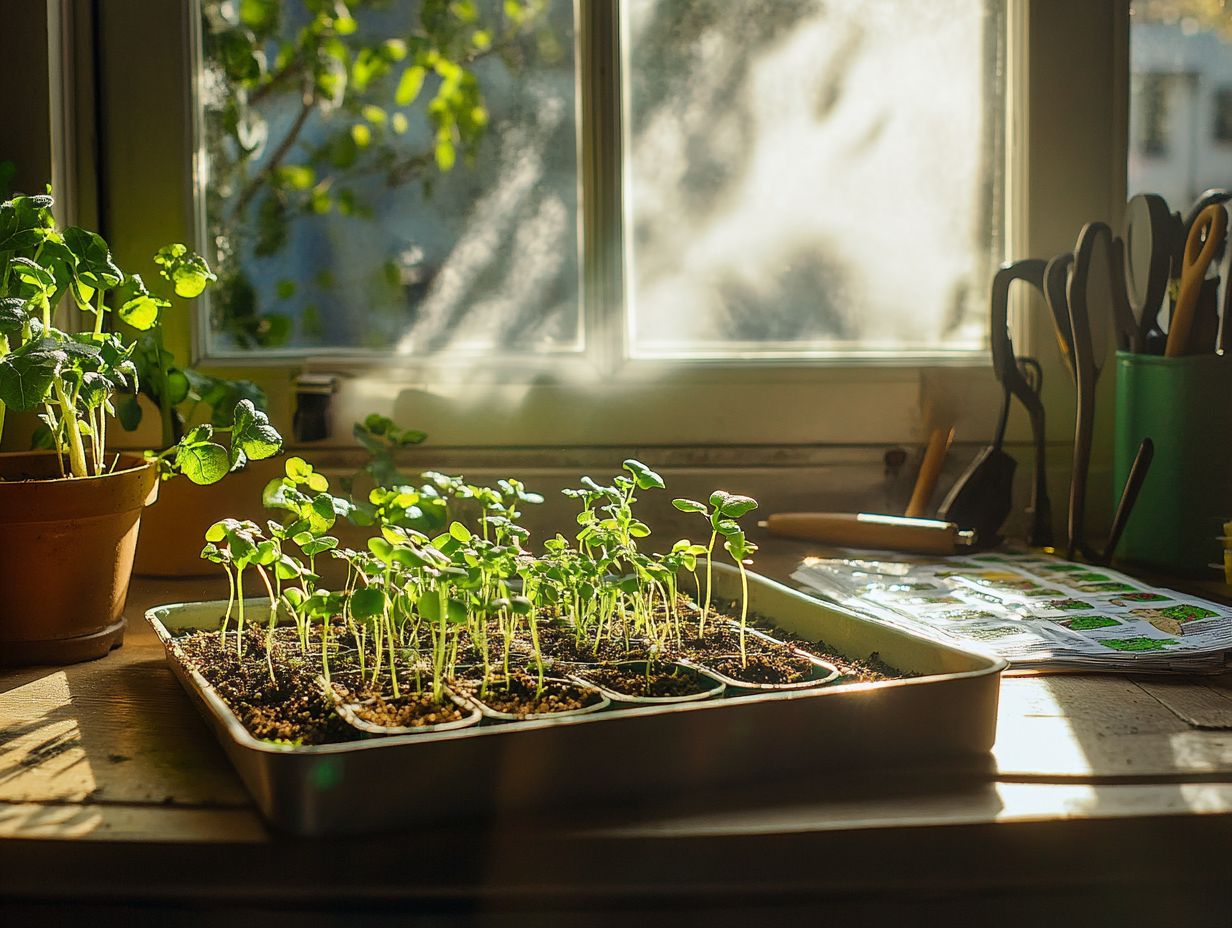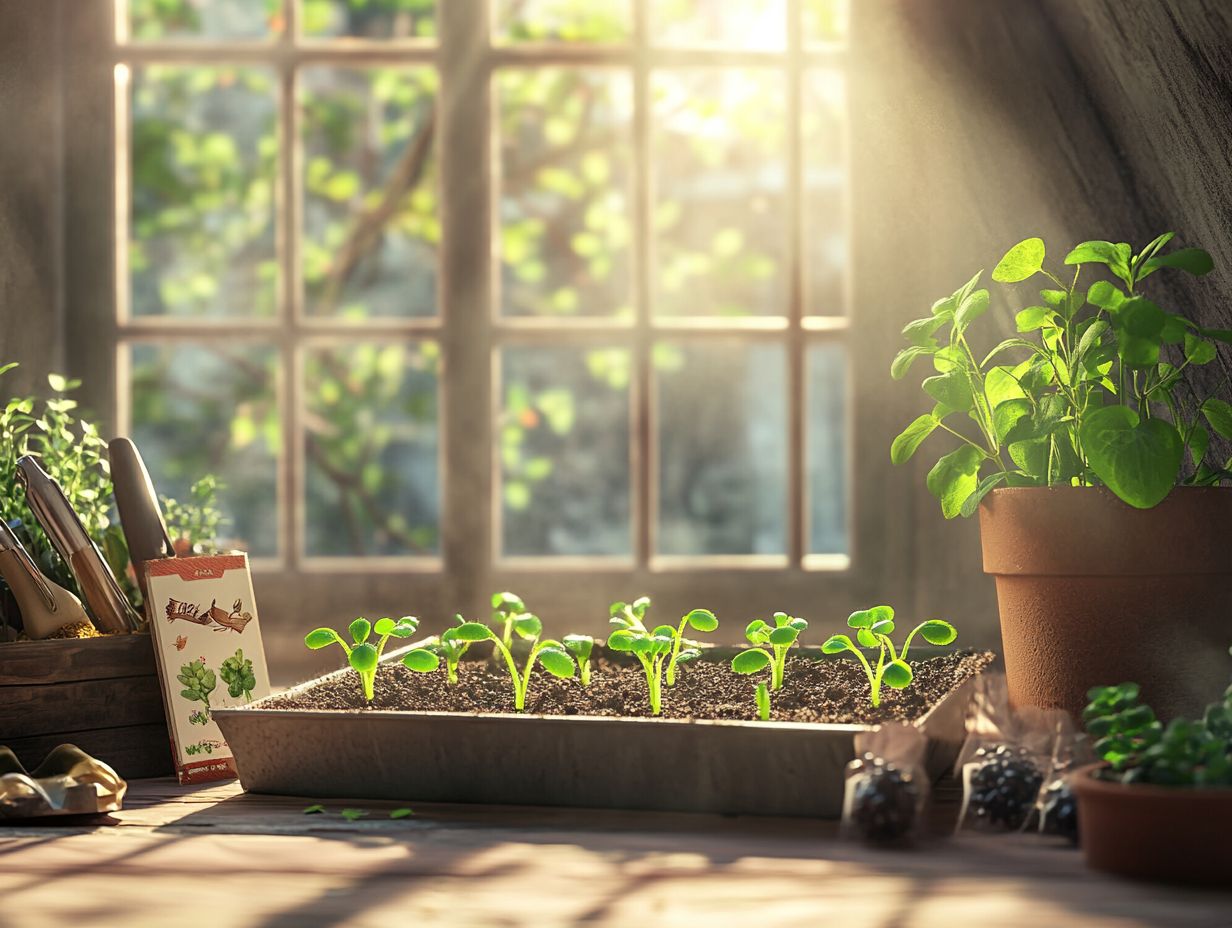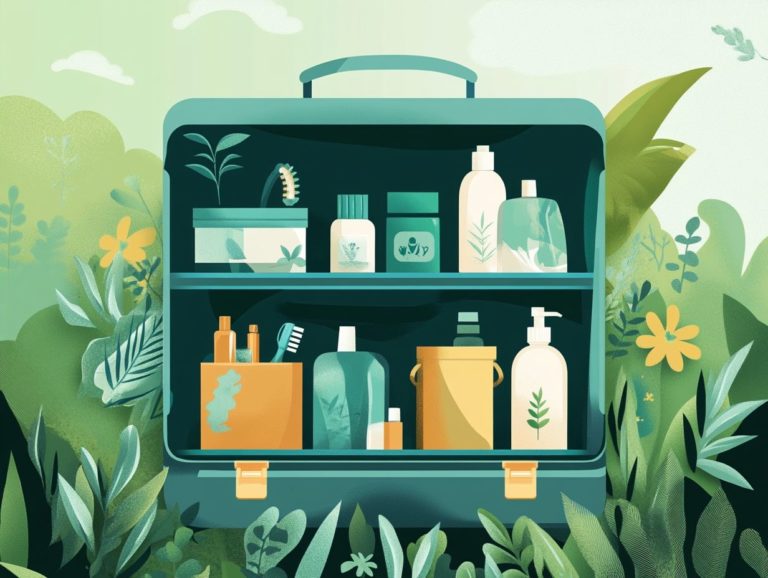How Can I Reduce Waste While Traveling?
Propagating indoor plants from seeds offers a rewarding and cost-effective way to expand your green space. Whether you re a seasoned gardener or just beginning your journey, this guide provides everything you need to know!
You ll find insights on gathering essential supplies, preparing your seeds, and the art of planting and caring for them. It also provides valuable tips on picking seedlings and troubleshooting issues like pests and diseases.
Dive in and unlock the joys of seed propagation!
Contents
- Key Takeaways:
- Supplies Needed for Propagation
- Preparing Seeds for Planting
- Planting and Caring for Seeds
- Transplanting Seedlings
- Troubleshooting Common Issues
- Frequently Asked Questions about Seed Propagation
- What is Propagation of Indoor Plants from Seeds?
- What are the Benefits of Propagating Indoor Plants from Seeds Using Different Propagation Methods?
- When is the Best Time to Propagate Indoor Plants from Seeds for Optimal Light?
- What are the Basic Steps for Seed Starting from Seeds?
- What Type of Lightweight Growing Medium is Best for Propagating Indoor Plants from Seeds?
- How Long Does it Take for Indoor Plant Seeds to Germinate During the Germination Process?
Key Takeaways:

Start with clean and soaked seeds for successful propagation.
Proper care and picking techniques are crucial for healthy seedlings.
Be prepared with essential tools and materials before starting the propagation process, including various container types.
Why Propagate from Seeds?
Propagating houseplants from seeds opens up an exciting avenue for you as a gardening enthusiast to cultivate new plants, providing a cost-effective and fulfilling way to enhance your indoor garden.
This approach allows you to explore a diverse array of houseplants, enabling you to experiment with unique varieties that may not be easily accessible as cuttings. Unlike cuttings, which can sometimes struggle to adapt, seed propagation nurtures strong and resilient plants right from the start. By grasping the intricacies of seed care, such as appropriate light conditions and optimal watering techniques, you can significantly boost plant growth and vitality. Additionally, learning how to propagate your favorite houseplants can further enhance your gardening journey.
Growing from seeds not only beautifies your home but also offers a rewarding journey that deepens your connection to the art of gardening. For those interested in expanding their indoor garden, learning how to propagate indoor plants in a terrarium delivers an enriching experience with each flourishing new addition to your indoor sanctuary.
Supplies Needed for Propagation
To successfully propagate houseplants, it’s vital to assemble the right supplies and materials tailored to your chosen methods. This ensures optimal conditions for seed germination and growth, encompassing proper seed care and light soil.
Selecting the appropriate containers, such as seed trays or pots, along with light soil, can greatly influence moisture levels and nutrient availability for your seedlings. Furthermore, having high-quality potting soil at your disposal is essential for the robust growth of your newly propagated plants. To enhance your indoor gardening experience, consider the best indoor plants for hydroponic propagation.
Essential Tools and Materials
Having the right tools and materials for seed starting is absolutely essential for ensuring the successful propagation of your houseplants, whether you re working with seeds or cuttings. Key gardening tools like sharp shears for cuttings, appropriate containers for seed starting, and effective watering methods significantly influence the development of your seedlings and their root division when needed.
Using translucent seed trays allows you to monitor moisture and light exposure, promoting germination while protecting the seeds from excessive water loss. A quality spray bottle becomes invaluable for gently misting the soil, maintaining humidity without over-saturating it, creating a nurturing environment for your young plants. Additionally, consider using propagation stations for indoor plants to enhance your gardening experience.
Labels are a must-have for keeping track of different varieties, so you can follow their care instructions accurately. Don’t overlook the benefits of a heat mat; it warms the soil, helping seeds germinate faster, especially for tropical species. Each of these tools not only simplifies your propagation process but also enhances the overall health and longevity of your plants. For those interested in expanding their plant collection, exploring the top 5 methods for indoor plant propagation can be invaluable.
Preparing Seeds for Planting

Preparing seeds for planting boosts your chances of successful germination and vibrant seedling growth. Key tasks include cleaning and soaking seeds to remove debris and promote moisture absorption key factors that help jumpstart the germination process.
By mastering the care of houseplant seeds, you can greatly influence the success of your indoor gardening ventures, especially when propagating indoor plants without soil, ensuring a strong and healthy beginning for each new plant you nurture.
Cleaning and Soaking Seeds
Cleaning and soaking seeds are essential steps that can significantly boost their chances of successful germination. By removing impurities and debris through proper cleaning, you ensure that the seeds can absorb moisture during soaking, which is crucial for germination. This simple step can lead to a higher sprouting rate and more robust plant growth.
To clean seeds effectively, rinse them in a small container with holes or use a fine mesh strainer to wash away dirt, mold, and contaminants. After cleaning, soak the seeds in water for about 8 to 24 hours. This duration allows the seeds to swell, kickstarting the germination process.
Maintaining the right moisture during soaking is key; over-soaking can lead to seed rot. These practices not only prepare the seeds for hydration but also promote healthier and more vigorous growth once they re planted.
Planting and Caring for Seeds
Effectively planting and nurturing seeds is essential for guiding them from germination to thriving houseplants. Understanding the various planting methods suited for different seed types is crucial.
By providing the right light conditions, moisture levels, and appropriate watering techniques, you can greatly influence the growth and health of your seedlings.
Implementing these seed care techniques enhances plant growth and lays the groundwork for a flourishing indoor garden.
Methods for Planting and Proper Care
There are various effective methods for planting seeds, each designed to cater to the specific needs of the plants you wish to propagate.
By adjusting the sowing depth according to seed size and providing appropriate spacing to prevent overcrowding, you create an environment that promotes healthy growth. Light conditions matter too; some seeds thrive in full sun, while others prefer partial shade.
Your watering method whether it’s a soft mist or a more thorough soaking will impact moisture retention and root establishment.
- Soft mist for gentle moisture
- Thorough soaking for deep hydration
These elements, along with the right temperature and soil type, facilitate successful seed germination and nurture seedlings into strong, flourishing plants.
Transplanting Seedlings

Transplanting seedlings is a crucial step in plant propagation, allowing young plants to thrive in a better-suited environment for strong growth.
Understanding the optimal timing and methods for transplanting whether into larger containers or different soil types is essential for their development. Effective root division techniques at this stage foster healthy growth and prevent root crowding.
When and How to Move Seedlings
Knowing when and how to move your seedlings is essential for their successful development. Transplanting at the right moment can significantly influence their growth and overall health. Wait until your seedlings have developed several true leaves and their roots are well-established before moving them.
By using proper transplanting techniques and following gardening advice, you can minimize stress on the plants, facilitating smoother transitions and better post-transplant care.
Pay close attention to root health; healthy roots should appear white and firm, indicating they ve reached a suitable size. Leaf development is another key factor; well-formed leaves signal that your seedlings are ready for a new home.
When the time comes to transplant, gently loosen the soil around the seedlings to avoid damaging the roots. Use a trowel to lift them carefully, ensuring the root ball remains intact. After transplanting, provide ample water and shade to help them acclimatize, reducing stress in their new environment.
Troubleshooting Common Issues
Troubleshooting common issues in seed propagation is essential for maintaining the vitality of your houseplants. This ensures robust growth while tackling pests and diseases that may emerge along the way. It’s also important to be mindful of nutrient levels.
Recognizing signs of distress like yellowing leaves or stunted growth is crucial for prompt intervention. Understanding how factors such as moisture levels and light conditions impact plant health allows you to adopt effective care strategies. This will help you navigate and mitigate these challenges with confidence.
Tackle Pests and Diseases
Tackling pests and diseases boosts your houseplants chances of thriving! Effectively managing pests and diseases is crucial for the successful propagation of your houseplants. These issues can significantly hinder growth and overall health. Identifying common pests like aphids and prevalent diseases such as root rot early on is essential for implementing effective plant care strategies.
By using appropriate treatments and preventive measures, you can ensure that your seedlings continue to develop strong and healthy. For instance, knowing the best time to propagate your indoor plants lays the groundwork for a thriving indoor garden.
Beyond pesky aphids, nuisances like spider mites and mealybugs can wreak havoc if left unchecked. Fungal infections can also lead to significant damage, causing wilting and discoloration. Establishing a routine inspection process is beneficial; this practice helps you spot any signs of distress early on. Understanding the germination process helps prevent these problems.
Simple steps, such as maintaining optimal humidity levels and ensuring proper drainage, can greatly reduce the risk of root rot. Using neem oil as a natural pesticide offers a safe and effective way to manage infestations without harming your plants. Additionally, learning how to propagate indoor plants with minimal effort can enhance your gardening skills. Ultimately, adopting a proactive approach to your gardening tips will fortify your seedlings, ensuring they remain resilient as they mature.
Frequently Asked Questions about Seed Propagation

What is Propagation of Indoor Plants from Seeds?
Propagation means growing new plants from houseplant seeds, cuttings, or other plant parts. For indoor plants, propagation from seeds is a popular method, allowing for a wide variety of plants at home, including African violet and Monstera.
What are the Benefits of Propagating Indoor Plants from Seeds Using Different Propagation Methods?
Propagating indoor plants from seeds allows for a wider variety at home. It’s a cost-effective method and can be a fun, rewarding process for plant care enthusiasts. Following proper gardening advice enhances your success.
When is the Best Time to Propagate Indoor Plants from Seeds for Optimal Light?
The best time to propagate indoor plants from seeds is during spring and summer when there’s more natural light and warmer temperatures. This helps seeds germinate and grow faster, ensuring strong growth.
What are the Basic Steps for Seed Starting from Seeds?
The basic steps for seed starting include preparing the potting soil or growing medium, planting the seeds at the right depth, providing adequate light and water, and ensuring proper ventilation for germination. Choosing suitable container types is also important.
What Type of Lightweight Growing Medium is Best for Propagating Indoor Plants from Seeds?
A well-draining, nutrient-rich potting soil is ideal for propagating indoor plants from seeds. You can use a specific potting mix for seeds or make your own by mixing equal parts of potting soil, peat moss, and vermiculite. Maintaining suitable moisture levels is crucial for success.
How Long Does it Take for Indoor Plant Seeds to Germinate During the Germination Process?
The germination time for indoor plant seeds varies depending on the type of plant and growing conditions. On average, it can take 1-3 weeks for seeds to germinate, but some plants, like Ficus Lyrata and coleus, may take longer.
Try propagating seeds today and share your experiences with indoor gardening!






